
Director’s Welcome
At Golden History Museum & Park, we are always striving to uncover and share stories of Golden’s past that are hidden or untold. In this issue of Discover magazine, be sure to read about the museum’s new Indigenous Connections Project—an effort to improve networks with Indigenous communities and elevate Native history and voices within the museum’s exhibits, programs, and collections. Over the next few editions of the magazine, we will feature excerpts from the new Indigenous Connections ethnographic report—a history of the Golden region from the perspective of Native Americans. Also be certain to check out the feature on East Tin Cup—a once bustling Wild West theme park built and operated by legendary Denver broadcasting icon Pete Smythe.
Staff

It’s bittersweet news to share that after 18 years of service to the Golden community, museum curator Mark Dodge has moved on to pursue new adventures. From managing the museum renovation in 2018, to digitizing and making our collection available online, to creating memorable content and exhibits, Mark made lasting contributions to the museum. We thank him for his dedication and are pleased to feature his final articles in this issue.
The search is now on for Mark’s replacement, and we plan to introduce a new staff member to you soon.
See you here soon,
DISCOVER I FALL
IN THIS ISSUE
Nathan Richie, Director

East Tincup Theme Park
Indigenous Connections Project Programs
The Most Famous Landmark in Golden Education Roundup
Staff & Volunteer Profile
Hand-on History School Break Programs

Donors
Membership
Homestead for the Holidays
Nathan Richie Britton Taylor Mark Dodge Vanya Scott Director Education Assistant Curator Curatorial Assistant
Jesse Gagnon Kathleen Eaton
Doug Skiba Andrew Terrill
Student and Interpretation and Development and Graphic Design Family Programs Visitor Experience Communications and Layout Coordinator Coordinator Editor (Discover) (Freelance)
2 DISCOVER I FALL 2022
2022
Hands-on History The Salon
Cover image: Pete Smythe stands on Main Street at East Tincup theme park in Golden, Colorado.
Photos © Golden History Museum & Park, City of Golden Collection
3 4 7 10 12 14 16 17 18 19 20
Hands-on History
Hands-on History summer camp is a fun-filled weeklong day camp for kids aged 6 to 12 in the beautiful Golden History Park.


Campers will use their hands as much as their brains, whether in Dirty Jobs, Pioneer Kids, or Frontier Explorers where they will pan for gold, make miners’ pickles, or dip candles.

In our full-day Silent Stars, exclusively for kids aged 9 to 12, campers will write, direct, and star in their own silent movie. Camps fill very quickly, so keep an eye on the calendar!
Exclusive members-only registration (Household level and up):
January 10 – January 23, 2023
Registration opens to the public: January 24, 2023.
Scholarships
Merit-based scholarships are awarded to children with a demonstrated interest in history. Download the application from the website. Scholarship applications are due Friday, February 3, 2023. GoldenHistory.org/HOH
Coming Soon to The Salon
Golden Folks: Photography by Povy Kendal Atchison
February 9 – September 2, 2023

Itold my soon-to-be husband that I would give Golden two years.
If I didn’t like it after that, we could move back to my fourth-generation home of Denver. Twenty-three years later, I am proud to call Golden my home.
People have always been my favorite subjects to photograph. My mother gave me her 1959 medium format Rolleiflex camera and the keys to her darkroom when I was 12. Forty-four years, seven books, and a few hundred publications later, I am still following my passion, which is also my profession.
For most photographers, it’s all about the light and composition, but to me, it’s also about the connection. Trying to get that person I’m photographing to open up to me and let me in. I hope that shows in my work. Combining my love for history and my need to connect with people, I have been documenting people of Golden since I moved here; well-known folks and not-so-well-known folks, but people who, in my left shooting eye, are worth notice. They are Golden Folks.

DISCOVER I GoldenHistory.org 3
Steve Kurtz, City of Golden Street Superintendent Photo © Povy Kendal Atchison
East Tincup: Where the Old West Lived Again, If Only Briefly
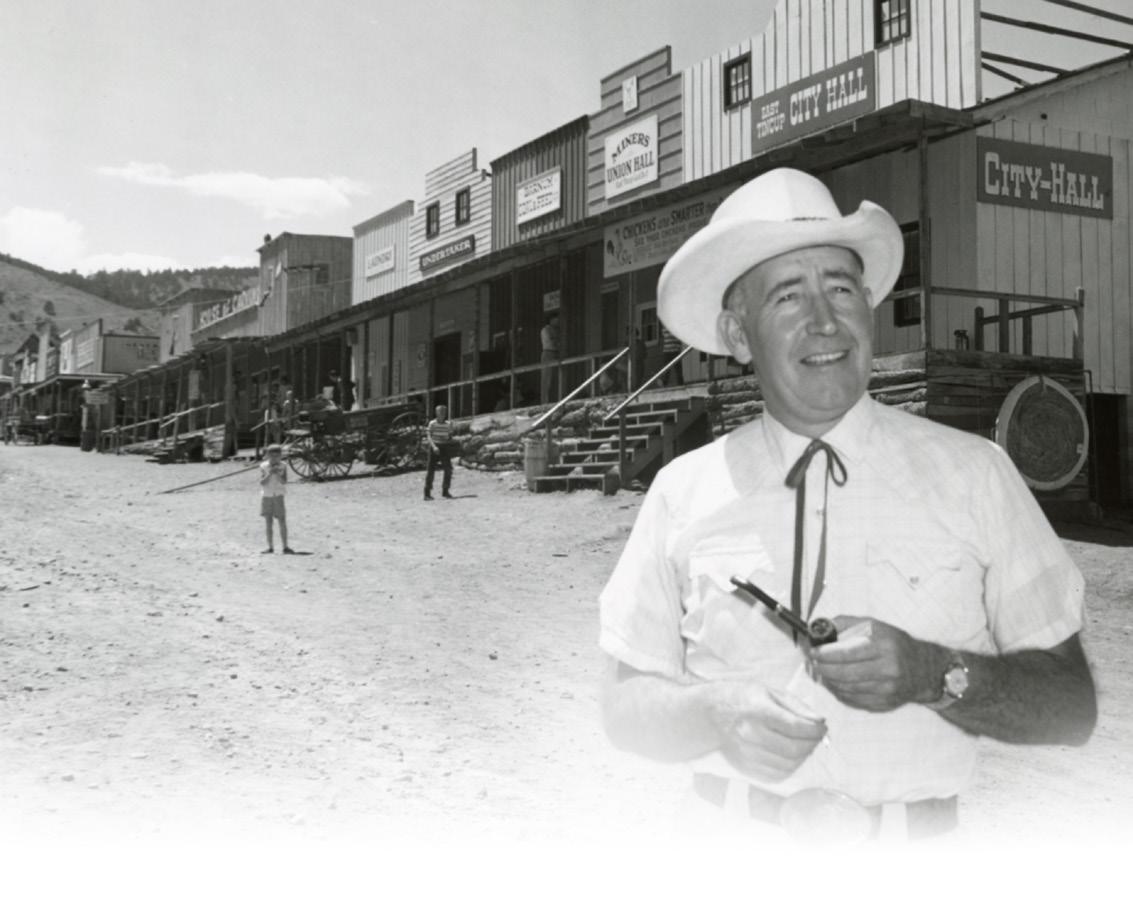 By Mark Dodge, Curator
By Mark Dodge, Curator
For a few short years, Golden was home to two different theme parks. East Tincup and Magic Mountain Amusement Park each drew inspiration from stereotypical elements of the American West. Both held official grand openings in 1960 and were located a scant half mile apart on Colfax Avenue in south Golden. Sadly, both succumbed to mismanagement and financial problems soon after opening.
Magic Mountain, one of the earliest theme parks in America after Disneyland, was designed to portray Colorado history, its development, and its exciting future. The park included a real narrow-gauge train, a cavalry post and stockade, and a period town called Centennial City. Sadly, Magic Mountain closed for good before the summer was over, and components were auctioned off
to pay for outstanding debt. (Much of the site sat idle until 1971, when new ownership reimagined the old park and reopened it as Heritage Square, which was open until 2015.) While the history of Magic Mountain is well documented, the story of a contemporary tourist attraction, East Tincup, just up the road at 18195 West Colfax Ave., is equally compelling.
4 DISCOVER I FALL 2022
Pete Smythe on Main Street at East Tincup theme park in Golden, Colorado.
East
(1960-1962): A trip back to the year 1880


East Tincup hosted a four-day grand opening celebration over Memorial Day weekend starting Friday, May 27, 1960. Jefferson County’s newest tourist attraction marketed itself as an old western town, circa 1880. Built in just 132 days during the winter of 1960 on roughly 12 acres near the intersection of Highway 6 and Highway 40 (Colfax Ave.) west of Denver, the village included 40 shops, restaurants, museums, and attractions. Between 50 and 60 seasonal employees brought the town to life, many from Golden High School and the Colorado School of Mines. It was open daily from 10 a.m. – 10 p.m. during the summer months, and upwards of 125,000 guests visited during that first season.

The project was spearheaded by East Tincup Inc., a corporation formed to establish the tourist attraction and western frontier town. The town was named after the mythical East Tincup, created and made widely known by popular Denver radio entertainer Pete Smythe, on his daily radio and television shows. Smythe’s daily broadcasts purported to originate from his general store in East Tincup, where he was mayor. The board of directors was comprised of Smythe, Dr. Nolie Mumey, and attorney Arthur Bowman.
East Tincup Inc. entered into an agreement with Business Products and Promotional Inc. led by Willis M. Webber Jr. to construct and operate the attraction. Webber constructed the replica 1880 town using many of the buildings that were once part of Pioneer Village, purchased the

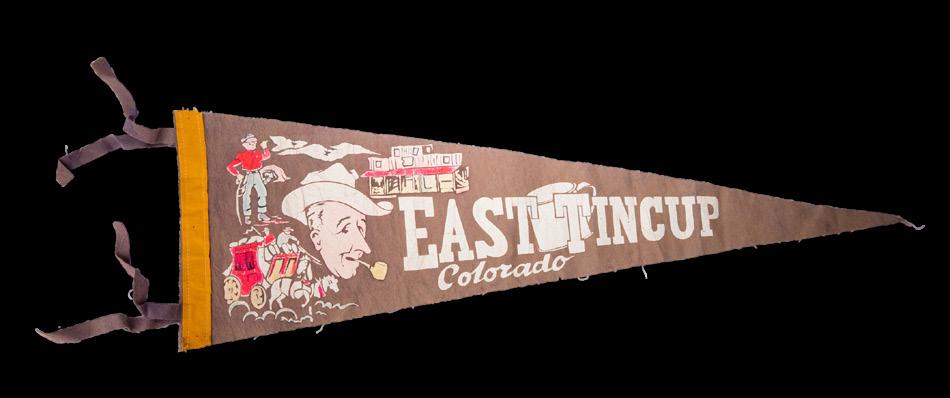
prior year. Originally set up in downtown Denver’s Civic Center, Pioneer Village was an attraction that existed through the summer of 1959. When it closed, the buildings were auctioned. Webber moved the buildings and used them to construct East Tincup in Golden.
Virginia Weigand’s “Avenue Flashes” in the Colorado Transcript called out the opening. “Colorado’s Oldest Weekly Newspaper salutes Colorado’s Newest Town, East Tincup, located just outside Golden’s city limits to the southeast—East Tincup, a dream come true for Radio-TV Personality
Pete Smythe and Willis W. Webber Jr., will hold its grand opening this weekend (Memorial Day 1960)—only a visit to the pioneer western village will prove to you the variety of interesting attractions which comprise this newest recreation center.”
A short article in a May 1960 Billboard magazine noted that the park opened its gates with a four-day celebration. Unfortunately, details of the actual opening events are mostly unknown, aside from a special appearance by Peter Breck, the frontier lawyer of TV’s “Black Saddle.” An inaugural brochure in the GHM&P collection enthusiastically calls out a number of advertised activities and attractions including daily gun fights in the streets, opportunities to ride the East Tincup stagecoach or railroad, Happy Easter’s gold mine, and authentic Indian dancers, alongside a replica town complete with a city hall, jail, school, church, and an official U.S. post office. All said, the park was home to more than 30 concessions.
DISCOVER I GoldenHistory.org 5
All photos © Golden History Museum & Park, City of Golden Collection unless otherwise credited.
Tincup
East Tincup pennant. Photo © Justin LeVett Photography
Grand opening advertisement from The Denver Post.
Continued overleaf
East Tincup featured a variety of entertaining attractions including a live show. Called Pete Smythe General Store, it was hosted by Smythe while the attraction operated. He barely disguised his voice to create his sidekicks, Elmy Elrod and Moat Watkins, among others. Famous personalities and musicians traveling through Denver were known to make appearances in the show, including Bob Hope and Nellie Lutcher. Another quirky attraction at East Tincup was Dr. Niblack’s Animation Land,


which was a woodcarver’s wonderland. It was filled with the creations of retired Denver chiropractor and self-taught carver, Dr. H. D. Niblack, who created thousands of carvings and caricatures of the Old West. According to a brochure, “You can spend hours among these fascinating displays. They depict trading posts, barber shops, dentists’ and doctors’ offices, circus rings, farm scenes, jury scenes, life-size Indians, and real miniature engines that actually run.”
The demise and legacy of East Tincup

After three successful seasons the town ran into trouble when the operators had a falling out. Willis Webber Jr. lost his lease and the buildings on the land in 1963 for failing to pay back taxes. Webber regained possession of some buildings, intending to move them to Estes Park, where he started anew under the name Rimrock. He planned to provide period western movie sets to the film industry. Lacking the funds to move the structures, Webber destroyed the remaining intact portion of front porches and sidewalks. The property owners, East Tincup Corp., vowed to rebuild but could not raise the money. What remained from the theme park was vandalized and ultimately auctioned off in 1964. Much of the old site is now home to a mobile home park, and as a nod to the past there’s a nearby convenience store named East Tincup Market.
Although East Tincup may have closed decades ago, recently stories and photos have emerged about its history. In 2021, Tracey Panek, historian for Levi Strauss & Co., shared a blogpost chronicling a large-scale advertisement for Levi’s Jeans that was painted on the face of a massive barn at East Tincup. After the site closed, the painted metal sign ended up in private hands until the Autry Museum of the American West in Los Angeles acquired it. Visit GoldenHistory. org/blog to read the article.
In 2022, Heritage Lakewood Belmar Park transferred several dozen black-and-white press photos to Golden History Museum & Park which are already shedding new light on this forgotten gem of Golden history. We only wish more artifacts remained from this wonderland of the West. If you have a good story to share about East Tincup tell us at info@GoldenHistory.org

6 DISCOVER I FALL 2022
Dianna Coleman traveled from New Mexico to donate her East Tincup pennant in 2021.
Indigenous Connections Project
ative American history and connections to the Clear Creek Valley and table lands of the central Colorado Front Range extend back for more than 12,000 years. Contemporary Native American communities continue to view this place as an aboriginal homeland and a living landscape. However, today’s historical narrative of the region largely excludes Indigenous people and their values. To address this disparity, the City of Golden formed a partnership between its divisions of Museums and Planning, with the additional support of the Historic Preservation Board, to engage Native American tribes and ethnographic researchers to help tell the story of indigenous people in this region. The study involved cultural advisors from six American Indian tribes and a review and synthesis of relevant ethnographic literature. Together, the oral historical and documentary records provide a robust narrative about Native American connections to Colorado’s Front Range and create a foundation for future collaborative research with tribal communities.
Situated within the ancestral territory of multiple tribes, the Clear Creek Valley can be understood as a place where multiple Indigenous lifeways were practiced. All the components that make up this area—including viewsheds, night skies, soundscapes, trails, plants, animals,

waterways, landforms, archaeological sites, and historical events—have value and significance to contemporary Native American people. Topography and habitats are some of the indicators of a homeland and cultural landscape to Indigenous people, as they provide physical and spiritual sustenance. The Clear Creek Valley provides an access corridor between the interior Rocky Mountains and the Plains. As an ecological transition zone, over 180 plant species found within the Golden region have documented Indigenous uses and names, and these serve as a foundation for Native American continued use and connections to the area. Ancestral sites have cultural and historical significance related to Indigenous lifeways and values on the landscape.
Tribal oral traditions and cultural activities continue to reinforce the long-standing connections tribes have to the region. In the oral histories of the Núuchiu (Ute), the area now called the City of Golden is located within the origin places of the Moghwachi, Tabeguache, and Uncompahgre bands and has been significant since time immemorial.
The oral histories and documentary record of the Tsétsėhést hese or Tsistsistas (Cheyenne) and Hinono’ei (Arapaho) reveal a history that began in the eighteenth century or earlier, and encompassed the Front Range of Colorado. Painful tribal histories, including the forced removal of the Utes from a

large portion of their ancestral lands, and the removal of the Cheyenne and Arapaho from Colorado following the Massacre at Sand Creek, are historically linked to the development of the City of Golden and are therefore essential components of Native American interpretation of the area. The City of Golden today recognizes that these oral traditions are an integral part to cultural identity and cannot be trivialized.
The publication Indigenous Connections: Native American Ethnographic Study of Golden, Colorado and the Clear Creek Valley can be downloaded free from the Museum’s Past Perfect Online Collection (GoldenHistory.org/PPO). This report is intended to be the very first step in cultivating strong relationships with Indigenous communities who continue to call Colorado home. We hope that this educational resource will be used widely and that other communities and cultural institutions will embrace and build upon this work for the greater understanding of the Indigenous presence in our region. Together we can share resources, ideas, and networks to work collectively to lift Indigenous voices in our communities. Community members are also invited to respond to a short, fourquestion survey to help guide our future work and help us prioritize what projects and initiatives the Museum should undertake next in this journey.
DISCOVER I GoldenHistory.org 7
N
Indigenous Connections Project
The following is an abbreviated excerpt of chapter one of Indigenous Connections: Native American Ethnographic Study of Golden, Colorado and the Clear Creek Valley.

Introduction
ANTHROPOLOGICAL RESEARCH, LLC, conducted an ethnographic overview of Native American use of the Golden region for the City of Golden and the Golden History Museum and Park. The purpose of this study is to provide the Golden History Museum and Park with a baseline of ethnographic research pertaining to six tribes associated with Golden Region. This report will serve as a foundation for engaging with Native American communities on how best to incorporate Native American interpretation into the Museum. The six tribes included in this study are (1) Cheyenne and Arapaho Tribes of Oklahoma, (2) Northern Arapaho Tribe of the Wind River Reservation, (3) Northern Cheyenne Tribe, (4) Southern Ute Indian Tribe, (5) Ute Indian Tribe of the Uintah & Ouray Reservation, and (6) Ute Mountain Ute Tribe (Figure 1.1).
The City of Golden, founded in 1859, is situated within a vast and complex landscape that has been continuously occupied by Indigenous people for more than 12,000 years. Contemporary American Indian tribes maintain cultural connections to sites along Colorado’s Front Range through prayer, visitation, government-togovernment consultation, oral traditions, and as residents of Front Range communities.
Native Americans are uniquely qualified to evaluate, interpret, and consult on their history and heritage resources. The majority of the ethnographic information in this report is derived from previously published sources, with emphasis on recent collaborative or community lead research.
This study is limited in scope due to limited funding and the project timeline. It focuses on only six of the 16 federally recognized tribes that the Golden Museum & Park has previously identified as being connected to the region. This overview should therefore be used as a foundation for future collaborative research and consultation with Native American communities. The Colorado State Office of Archaeology and Historic Preservation currently provides a list of 48 federally recognized Indian tribes that claim all or part of Colorado as ancestral territory. Previous ethnographic studies along Colorado’s Front Range have identified 28 federally recognized tribes historically associated with the Front Range.

Methodology
Research for this study was conducted through outreach to tribal communities, a review of relevant ethnobotanical and ethnographic literature, and review meetings with official tribal cultural advisors and representatives. Researchers adopted a cultural landscape approach to this study. The concept of cultural landscapes centers on the interconnectedness of place and people. Cultural landscapes can be understood like ecosystems, wherein diverse elements— including villages, campsites, trails, caves, origin places, medicine places, plants, ceremonial sites, and other important locations—are related and inextricably linked to each other and to the experiences and
8 DISCOVER I FALL 2022
Figure 1.1 Native American reservations discussed in this report in relation to the City of Golden.
perceptions of the people. This approach is inclusive and aligned with tribal values for ancestral lands. To best represent Native American connections the geographic scope of this study includes places up to 150 miles from the City of Golden and is referred to in this report as the Golden Region. Places found within this region are important to the traditional use of the area. To provide relevant ethnobotanical information to the City of Golden and to tribal communities, a 40-square-mile area centered around the City of Golden was considered.
The Anthropological Research team, consisting of Sean O’Meara, Michael Spears, T. J. Ferguson and Maren Hopkins, conducted this study in collaboration with the City of Golden. Mr. O’Meara served as the primary ethnographic researcher; Mr. Spears provided GIS support and was the project cartographer; Dr. Ferguson and Ms. Hopkins provided administrative and editorial support. Nathan Richie, Director of the Golden History Museum & Park, and Lauren Simmons, Senior Planner at the City of Golden, facilitated this study and provided outreach assistance.
Native American Outreach and Engagement


In July and August of 2021, Anthropological Research and the Golden History Museum & Park contacted the Tribal Historic Preservation Offices of six tribes to request their participation in this project and provide an opportunity for them to discuss how they would like to engage in the study (Table 1.1). Based on the scope and timeline of the project, tribes requested to review a synthesis of previously published materials prior to ethnographic interviews and consideration of interpretative themes, ethnohistory and recommendations for the Golden History Museum & Park.
Literature Review
The researchers reviewed ethnographic, historical, and archaeological documents relevant to Native American history in the Golden region. Aboriginal territory maps were digitized using GIS based on feedback from cultural advisors; archaeological sites in Golden were assessed using the Office of Archaeology and Historic Preservation’s Compass database, published ethnobotanical
and traditional-use information was compiled to serve as a baseline in future studies. Anthropological Research staff worked with each tribe’s Tribal Historic Preservation Office and Cultural Preservation offices to identify relevant sources. Information was obtained through online research of the several research institutions and databases, including the Southern Ute Cultural Preservation Department archives, Rocky Mountain Online Archives; History Colorado, Denver Public Library, Denver Museum of Nature Science, Library of Congress, New York Public Library, the Smithsonian, and the Museum of the American Indian. Ethnographic literature should be viewed as supportive material and not a replacement for in-depth ethnographic interviews.
Ethnographic Interviews
The research team developed an informed consent and preliminary set of questions for the ethnographic interviews based on the results of the literature review. Following the completion of the draft report, Anthropological Research conducted followup interviews via zoom or teleconference. This report summarizes the relevant parts of those discussions. Specific quotes or information provided by cultural advisors provided during these conversations can be found in this report.
Tribal Review
The research team maintained regular contact over email and through virtual meetings with tribal representatives over the course of the project. The research team incorporated material from the literature review, interviews, and conversations with cultural advisors into this report. Virtual meetings were held between the research team and participating tribes to review the content of the report. These review meetings gave the tribes an opportunity to ensure the accuracy and appropriateness of information pertaining to their tribe that is shared in this report. During review meetings, the relevant chapter was read in its entirety. Tribal chapters were revised based on the feedback derived in the interviews.
Learn More
Visit:
GoldenHistory.org/ethnography to read the report in full. A survey link is included on that page. Please participate and help guide the Museum’s future work and initiatives. Finally, watch the website and Discover magazine for updates on future engagement opportunities related to this ethnographic study.
DISCOVER I GoldenHistory.org 9
A Ute encampment of núugani along the South Platte River near Denver, Colorado, 1874. Photographer unknown, Denver Public Library Special Collections, Catalog No.X-30649..
Programs
These programs are subject to change. Go to GoldenHistory.org/events for the most up-to-date details. Programs are free for members and $10 for non-members (plus eventbrite fee), unless otherwise noted.
All activities at Golden History Museum unless otherwise noted.
October 27, 2022, 6 – 8 p.m. History Trivia Night
Build a team and join us at the museum for a special history trivia night! There will be themed categories about both Golden and Colorado. Teams (of no more than 4) will test their knowledge and vie for the title of champion. Advance registration is required. Light refreshments and snacks will be provided.

$20 per team for members, $30 per team for non-members
1
Colorado School of Mines students, c. 1960s.

November 16, 2022, 6 p.m.
Drinking in — and Drinking Your Way Through — Colorado’s History and Beauty
Author Ed Sealover will guide you through historical, natural, and drinking adventures around the state—the subject of his recently published book.
Coors Employee Hospitality Bar, 1894.
December 17, 2022, 2 – 5 p.m.
Homestead for the Holidays

Golden History Park
Homestead for the Holidays lets you experience the winter season just like the pioneers did! Stroll through the History Park, take in the colorful decorations, and make a craft to take home.
Member adult: $5
Member child 5-17: FREE
All children aged 4 and younger: FREE
Non-member adult: $10
Non-member child aged 5-17: $5
Photos © Povy Kendal Atchison
January 14, 2023, 1 p.m.
Ranching Women of Colorado
Join historian and author Linda Womack to hear the colorful stories of women ranchers in Colorado who thrived in roles outside conventional norms.
Mr. and Mrs. Todd at their Golden-area cabin.
February 15, 2023, 6 p.m. Brands in Colorado
Returning speaker Randi Samuelson-Brown, originally from Golden, Colorado, will entertain our audience with exciting tales of cattle rustling, shady characters, and stock detectives. She was a finalist in the 2021 Colorado Book Awards for The Bad Old Days of Colorado and has just released Brand Chase – Book #1 of the Dark Range Series.
Thomas Tripp on Washington Ave., c. 1915.
March 18, 2023, 6 p.m.
Political Cartoons, Masculinity, and Women’s Activism in Colorado, 1900-1925
Join Metro State University professor Todd Laugen as he discusses broader trends in reform and women’s activism in Colorado, using political cartoons which drew scathing critiques of political corruption and manipulation in the early 20th century.
10 DISCOVER I FALL 2022
1 2 2 3 4 5 6 3
April 19, 2023, 6 p.m.
Homesteading the West - The Tale of Lavinia Morgan Anderson
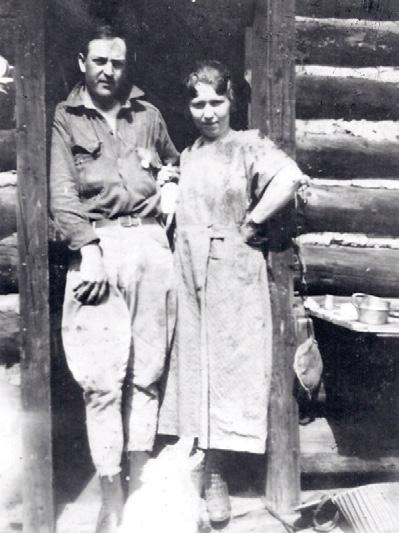


We welcome back acclaimed storyteller Linda Batlin for a costumed interpretation of Lavinia Morgan Anderson, a composite character of a pioneer woman living on a ranch in 1880s Colorado. Batlin is based in Boulder and enjoys sharing her love of the mountains and of Colorado with audiences. Her recent performance of Isabella Bird’s 1873 travels is available for viewing on the Members Only portion of GoldenHistory.org.
$5 for museum members, $10 non-members
Wannemaker family cabin in front of South Table Mountain, 1860.

April 21, 2023, 6 p.m.
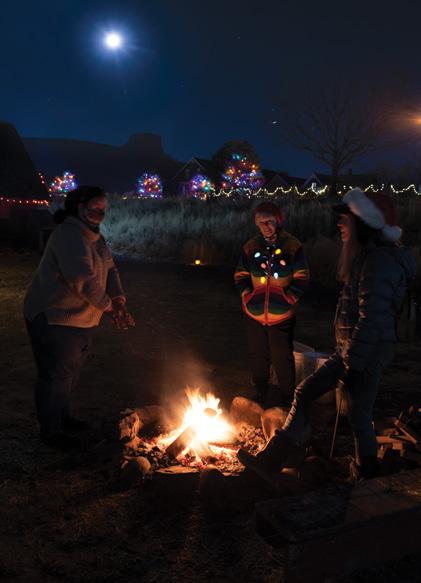
Borderlands Curanderos
Join Metro State University professor Jennifer Koshatka Seman, author of Borderlands Curanderos: The Worlds of Santa Teresa Urrea and Don Pedrito Jaramillo, as she discusses U.S.-Mexico Borderlands during the turn of the twentieth century.
DISCOVER I GoldenHistory.org 11
4 5 6 7 7
Photos © Golden History Museum & Park, City of Golden Collection unless otherwise noted.
in Golden Landmark The Most
By Mark Dodge, Curator
It’s impossible to imagine Golden without its iconic welcome arch over Washington Avenue.
A relative newcomer to town, Lu Holland was civic-minded and wasted no time promoting his Holland House business and new hometown. He joined the Golden Chamber of Commerce and soon found himself in a leadership role as president, serving from 1948-1950. In 1949, Lu presented an aggressive agenda that included new four-lane highways serving Golden, a new courthouse, a new high school, teeming businesses, and a new neon welcome arch over Washington Avenue, most of which would eventually happen.

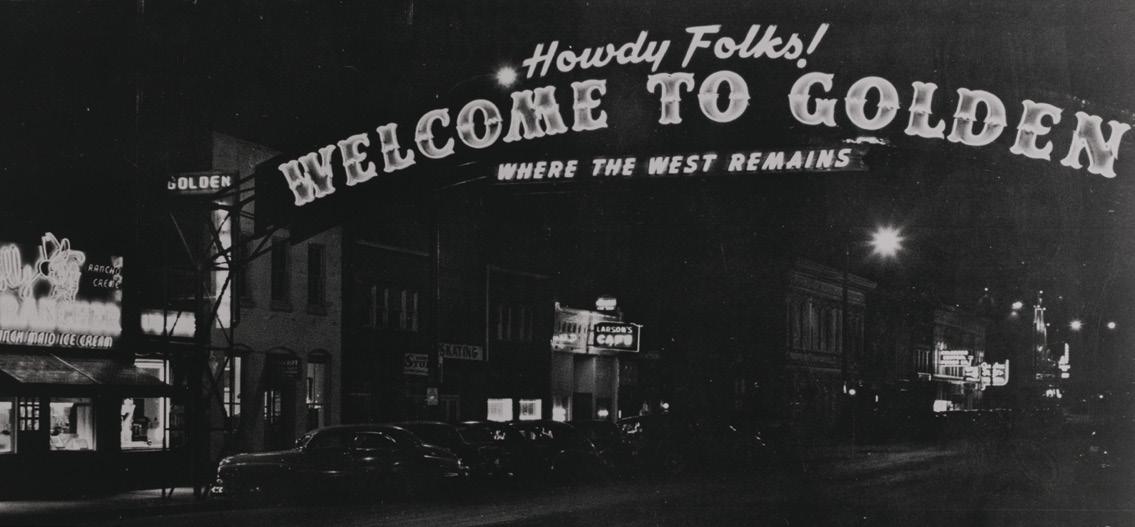
He envisioned big things for Golden. This meant standing up to big-city forces in Denver which were interested in annexing portions of Jefferson County. Golden is
“Where the West Remains,” Mr. Holland declared, suggesting that all Jefferson County communities west of Denver should unite for their own benefit under the name of Golden. “To Denver we are serving notice to stay back of your line; expand to the Kansas border if you want, but we’ll take care of everything between here and the foothills,” he admonished.
A welcome arch over Washington Avenue was one of his first accomplishments despite less than enthusiastic support from Chamber members. Holland estimated it would cost roughly $5,000 and even donated the first $1,000. Ultimately, it cost $7,500, and the Hollands paid for most of it. You wouldn’t know it today, but it was somewhat controversial at the time. It still endures as one of Golden’s most iconic and beloved landmarks.
12 DISCOVER I FALL 2022
‘‘ ‘‘
Famous
No single project is more important to Golden than this arch…
For Golden it will make a new face, a new spirit, and a new thinking.
-
Lu
Holland speaking to the Golden Chamber of Commerce
members.
Greg Holland, Lu’s grandson, shared this in 2019:
I thought you might want to know the motivation behind Golden’s arch. My grandfather, ‘Lu’ Holland, was a young cowboy when he first came to Colorado. His specialty was breaking horses. He would hire on with an outfit or a ranch and work with the untrained horses. Once they were all broken, his job was completed, and he would move on to the next outfit. He worked his way across Texas and Oklahoma ending up in Denver sometime around 1906.
At this point, he turned in his saddle and spurs for a French knife and a chef’s hat. Training under the old German chefs at the Brown Palace, he spent a number of years perfecting his new craft. Once he earned the title of “chef,” he struck out on his own, opening the Pine Grove Café in downtown Denver.
Years later, at the Holland House in Golden, I asked him why he put up the arch.
He spoke of his travels as a cowboy and how miserable he felt when he’d come across people who were indifferent or rude when entering a new town or area. To this day, he said, he would never go back to such a place because of the bad impression those uncaring folks made on him. On the other hand, every place he went where he was welcomed in a friendly manner made him feel wonderful. Somewhere along that road, he determined in his heart to make a special point of offering a friendly “Welcome” to any traveling strangers he would come across. He called it the first part of “western hospitality.” Once he had established himself in Golden and had become president of the Chamber of Commerce, he decided to do something to welcome all travelers and passersby to our town. He wanted something that might inspire western hospitality among Goldenites and more importantly, give even the weariest of travelers the comfort of knowing that they were truly welcome in this place.
How could such a thing be accomplished? Was there something that would actually work and be consistent in delivering the message? The arch was his answer. He could put a concise and simple message proclaiming to one and all that they are valuable and precious to us and we’re glad that they are here.
That message, written in large letters spanning Washington Avenue said, “Welcome to Golden,” and underneath in smaller letters, “Where the West Remains.” That slogan greeted travelers for about 30 years and was changed to “Where the West Lives” in the 1970s.

My grandfather would say, “If a place makes you feel that good about being there, aren’t you going to come back, aren’t you going to stay longer, aren’t you going to tell your friends about it?”
I don’t know if Golden realizes it, but it’s been given a great distinction above all other places. It has been given the honor of being the “Seat of Western Hospitality.”
Fun facts about Golden’s Welcome Arch
DISCOVER I GoldenHistory.org 13
The arch is City of Golden property.
The arch was added to the Colorado State Register of Historic Properties on June 14, 2000.
The original slogan, “Where the West Remains,” was changed to “Where the West Lives” during a 1979 facelift.
Education
Roundup
By Jesse Gagnon
A New Outreach Program Helps Connect Students to Ute Traditional Knowledge

The Golden History Museum & Park is pleased to announce that we have been chosen as a partner organization to help History Colorado facilitate their new educational outreach program, Ute Knowledge History TakeOut Kit, in our local community. This kit helps students explore the integration of Western science, technology, engineering and math (STEM) and Ute traditional ecological knowledge. This educational program encourages students to understand the history of the Ute people and their struggles while also demonstrating how the Ute people have survived and continue to thrive as important members of our community.

Who are the Ute People?
The Ute people are one people, many bands, and today, three tribes. Their long history goes back generations and was shaped by interaction with their environment and their neighbors. Historic changes since 1849 have dramatically impacted the Ute people’s way of life. Their relationship with the land shapes their language, dances, and ceremonies. The Ute people’s place in their tribes, their bands, and their families form their identities as Ute. They are Colorado’s oldest continuous residents and are still here today. The Ute people live in the modern world and carry on their traditions.
What is Traditional Ecological Knowledge?
Traditional Ecological Knowledge, also called by other names including Indigenous Knowledge or Native Science, (often abbreviated as TEK) refers to the evolving knowledge acquired by indigenous and local peoples over hundreds or thousands of years through direct contact with the environment. This knowledge is specific to a location and includes the relationships between plants, animals, natural phenomena, landscapes, and timing of events that are used for lifeways, including but not limited to hunting, fishing, trapping, agriculture, and forestry.
14 DISCOVER I FALL 2022
Kit Highlights
Giant Map of Colorado
A large cloth map of Colorado allows students to identify modern map features such as state lines and towns, directional resources such as the compass rose, and natural features important to the state such as mountains, plains, foothills, valleys, and water. Once students have been introduced to the map, a museum educator can transition to a discussion of the Ute people, including their traditional territory and their modern communities and reservations.

Activity Boxes
This kit includes six activity boxes that allow students to explore how the Ute people solved problems to survive and thrive within their environment, using what we would consider science, technology, engineering and mathematics (STEM). Potential themes
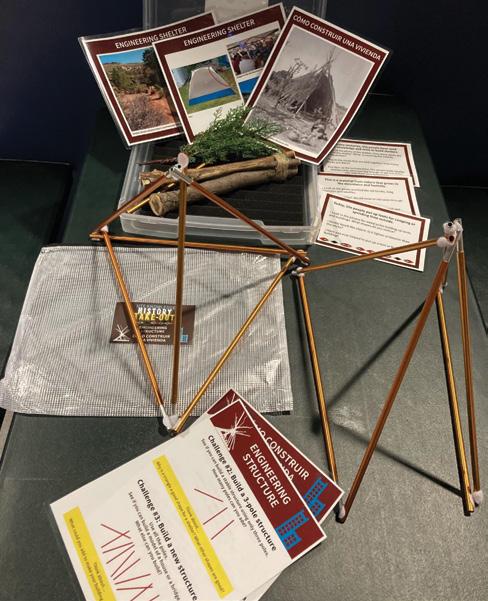
to explore include Engineering a House and Science for Food. Each activity box allows 2-3 students to work together to investigate their individual topic. Students first complete a matching activity, where students match a series of three images, to three clue cards, to three objects. One object represents an environmental material, one represents a solution from the past, and one represents a solution from the present. Once students have completed their matching activity, they move on to a series of challenge activities where they will test their knowledge to solve a new problem.
To learn more about GHM&P’s different traveling outreach programs visit GoldenHistory.org under Learn and At Your School
Thank you to History Colorado for granting the Golden History Museum & Park a Ute Knowledge History Take-Out Kit. Information for this article came from the program’s educator manual created by History Colorado. The Ute Knowledge History Take Out Kit is part of the Ute STEM Project, supported by the National Science Foundation. This program is possible through the expert knowledge and generous efforts of the representatives of Southern Ute Indian Tribe, The Ute Indian Tribe of the Uintah and Ouray Reservation, and the Ute Mountain Ute Tribe (“The three Ute Tribes.”) and was developed by History Colorado. Learn more about History Colorado at HistoryColorado.org.

DISCOVER I GoldenHistory.org 15
Staff Profile Britton Taylor

Ithink I have always found history interesting. When I was young, my family and I lived in Columbia, Maryland, where my parents would always take my siblings and I to the Smithsonian Museums in the Washington D.C. area. I can remember visiting the National Air and Space Museum and going to the Lincoln Memorial where history and science would come alive for me. Not only was I interested in general history but I was also interested in my own family history. As a child I could also be found sitting at the feet of my grandmother listening to stories about our family members that lived before us. When I was in middle school, my parents moved our family to Colorado and in high school I had an amazing history teacher that made the past exciting and encouraged me to pursue my passion of learning history. These experiences drove me to pursue a BA in History and a Minor in Marriage and Family Studies at Brigham Young University-Idaho.
During my time at school, I discovered that I loved teaching children and that I loved history. So why not do both? Upon returning from college, I did an internship with the History Colorado Center where I facilitated field trip tours for K-12 students in the Denver Metro Area. This grew into a parttime position where I also helped create and facilitate curriculum for their new summer camp program. At around this time, I also started working for Golden History Museum & Park as a Building Colorado Facilitator and later went on to be a Hands-On History Camp Facilitator. Both experiences have grown my love for working in small museums and has led me to my current role as the Education Assistant. Among my goals are to grow our current programs of Building Colorado, our Jr. Homestead Days field trip experience, and our Hands-On History summer camps, but to also build kid-friendly museum experiences that encourage a love and interest in history.
Volunteer Profile Bill Calmette
Bill was born and raised in Golden. In fact, he was delivered in a small house by a midwife where the Wells Fargo parking lot sits today! He is a 1964 graduate of Golden High School, but left the state to attend Nebraska Wesleyan University, earning a degree in psychology and sociology. After graduation, he taught for a year with the Nebraska School for the Visually Handicapped (now the Nebraska Center for the Education of Children Who Are Blind or Visually Impaired).
Bill served in the army for three years as the assistant ward master in a psychiatric ward. After he was discharged, he decided it was time to do some traveling, and traveled up and down the west coast from San Diego to Vancouver for 10 years. He was never without work as he had learned to bartend
at the Heritage Square Opera House while still living in Golden.
In the late 1980s, he finally returned to Golden to be with family. He worked at the Heritage Square Opera House before becoming a travel agent, but the long days sitting at a desk weren’t for him. He also worked for a small catering company in Denver, as the event coordinator at the American Mountaineering Center, and as a groundskeeper at the Golden Hotel before
retiring. All in all, Bill estimates he’s had over 50 jobs in his life!
Bill joined the museum in November 2017 as it seemed like a great place to welcome people to Golden and share the history of his hometown. You can also find him at the Golden Visitor’s Center where he started as a volunteer a few years ago. In his down time, Bill loves gardening, caring for the multitude of flowers in his yard, and spending time with his dog, Gracie.

16 DISCOVER I FALL 2022
Hands-on History
School Break Programs

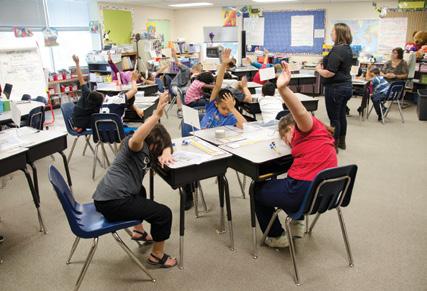

Join us at the Golden History Museum & Park when school is out!
During these half-day programs for ages 6-12, participants will explore science, art, history and more while enjoying the unique setting of our history park, whether it is a visit to the chickens or cooking something in the historic Pearce/Helps Cabin. Space is limited. Dates coincide with no-school days for JeffCo Public Schools.
Enchantments and Mysteries
October 20 - 21, 2022; 9 a.m. – 12 p.m.
In preparation for Halloween, participants will explore the history behind this holiday through games and experiments; there might even be a little magic. Each day will feature a unique schedule; register for both days so you do not miss out.
Limited to 20 participants per day.
Historical Concoctions
November 21 - 22, 2022; 9 a.m. – 12 p.m.
Did you know that Jolly Rancher was started in Golden, Colorado, or that Coors made pottery and malted milk for candy bars? Over two days, participants will experiment with mixing and matching materials and ingredients. Each day will feature a unique schedule; register for both days so you do not miss out.
Limited to 20 participants per day.
Pricing (per day)
Member*: $35
Non-member: $45
*Member prices require a current Household membership or higher. Registration will be through Active.
Location and Daily Schedule
Participants will be dropped off and picked up at the Golden History Museum (923 10th St, Golden, CO 80401). Most activities will take place at the Golden History Park (1020 11th St, Golden, CO 80401) across the creek in the Reynolds education cabin.
Daily Schedule
Morning drop-off: Between 8:45 and 9 a.m. (please make sure you arrive by 9:00 a.m.)
Afternoon pick-up: between noon and 12:15 p.m.
Supervision and Ratios
Campers will be supervised at all times by museum staff. There is an average ratio of one teacher for every 12 campers.
Refund/ Cancellation Policy

Cancellations received two weeks before the start of program will receive a full refund. Registrations received by 4 p.m. the Monday before the scheduled program will receive a 50% refund.
Registrations received on the Tuesday before the scheduled program or later will receive no refund.
DISCOVER I GoldenHistory.org 17
Golden History Museum & Park
Donors January — December, 2021
$10,000+
Linda and Dale Baker City of Golden Colorado Humanities
Pat Spieles Scientific and Cultural Facilities District
The Denver Foundation, Greenwood Fund

Downtown Development Authority
Mark and Nancy Foster
Golden Civic Foundation
Richard and Cynthia Bauman
Jennie and Charles Boeder
Lydia Andrews-Jones and Jason Matisheck
Michelle Barnes and Rick Taylor
James and Joy Bauman
Bill and Carol Bleau
Shelly and Nick Bleckley
Betty Bloom
Sarah and Joe Brenkert
Gerald E. Brown
John and Kathe Buhr
Nancy and Dick Bureson
Linda Churches
Thomas and Julie Clark
Jim and LouAnne Dale
Jim and Odile De La Beaujardiere
Ingrid Depta
Pat Donahue and Kevin Skeate
Kathleen Doyle
Ted and Paula Dreith
Edward Jones
Ewers Architecture
Sheryl and Steve Fassino
Katherine and Garrett Fleming
Kristine and Kevin Fletcher
Richard Flint
Larry and Barbara Foos
Norma Fricke
$1,000 — $9,999
Golden Kids Dental and Orthodontics
Connie Hauver
Kathleen Weller Horky and Kevin Horky
Elaine and Joseph Marolla
McKee Family Foundation
$500 — $999
Justin LeVett Photography
Sharon and Robert Kirts
$100 — $499
Dorothy and Michael Gleason
Betty and Thomas Gleaton
Wendy and Rick Goad
Martha Gould
Gene Gray
George Griffin
Elnore and Ron Grow
Lynne Haigh
Paul and Vivian Haseman
Margaret B. Henderson
Steve Hughes and Sue Cornish
Frank and Gaye Jacobs
Joyce Jennings and William Cox
Janet Johnson
Paul and Karen Jones
Rachael Kenney-Reid
John and Karen Lynch
Esther and Don Macalady
Mary Anna and Walter Madden
Helen McVey
Tara Meininger
Meyer Hardware
George Meyers and Merrill Wilson
George and Susan Mitchell
Jan Monnier and Mike Fehn
Geraldine and Mel Moore
William and Jean Parfet
John and Andi Pearson
Danielle and Louis Samuels
Lynette and Jeffrey Vann
Justin and Sarah Wade
Pat and Judy Madison
Jean Theobald
Wendy Potthoff
Julie A. Ramstetter
Charles and Mary Ramstetter
Stony and Theresa Shelton
Jane A. and Kim E. Sikoryak
Jack and Catherine Skokan
Susan Speer
Larry and Penny Storms
Sherry and Roger Stuart
Stephen and Beatrice Szadokierski
Cynthia Szymanski and Jason Robertson
Michael and Marla Tamburro
Michael Tamny and Cynthia Merrill Tamny
Clare and Charlie Taylor
Dixie Termin and Ron Miller
Marsha Trout
Barb Warden and Frank Blaha
Jon and Judith Watson
Larry and Betty Weaver
Tom Weimer
Laura and Michael Weinberg
Angela and Tom Wheaton
Jeanne Whittaker
J. Richard and Judith Williams
Mike and Mary Wood
Alan and Elizabeth Woodard
18 DISCOVER I FALL 2022

DISCOVER I GoldenHistory.org 19 Membership Be a part of Golden history. Become a member today! Join or Renew Today Call, mail, or stop in. 923 10th St., Golden, Colorado 80401 l 303.278.3557 GoldenHistory.org/member Thank you for supporting Golden History Museum & Park YES, I want to support Golden history. Director’s Circle ($1,000) Founder ($500) Benefactor ($250) Patron ($125) Household ($75) Dual ($60) Individual ($40) Seniors (65+) may deduct 10%. Please accept my extra, tax-deductible donation of $25 $50 $100 $ (other) Total enclosed $ Name Address City, state, zip Credit card # Exp. date Signature Phone Email (opt-in for e-newsletter, opt out anytime)
Homestead
Saturday, December 17, 2022, 2 – 5 p.m.

omestead for the Holidays lets you experience the winter season just like the pioneers did. This family-friendly event will have you strolling through the Golden History Park, taking in the colorful decorations, making a craft that you get to take home, and basking in the season. It’s time to go homestead for the holidays!
Our valued volunteers make this event possible and will serve as interpreters within the historic structures to answer questions and guide your experience.
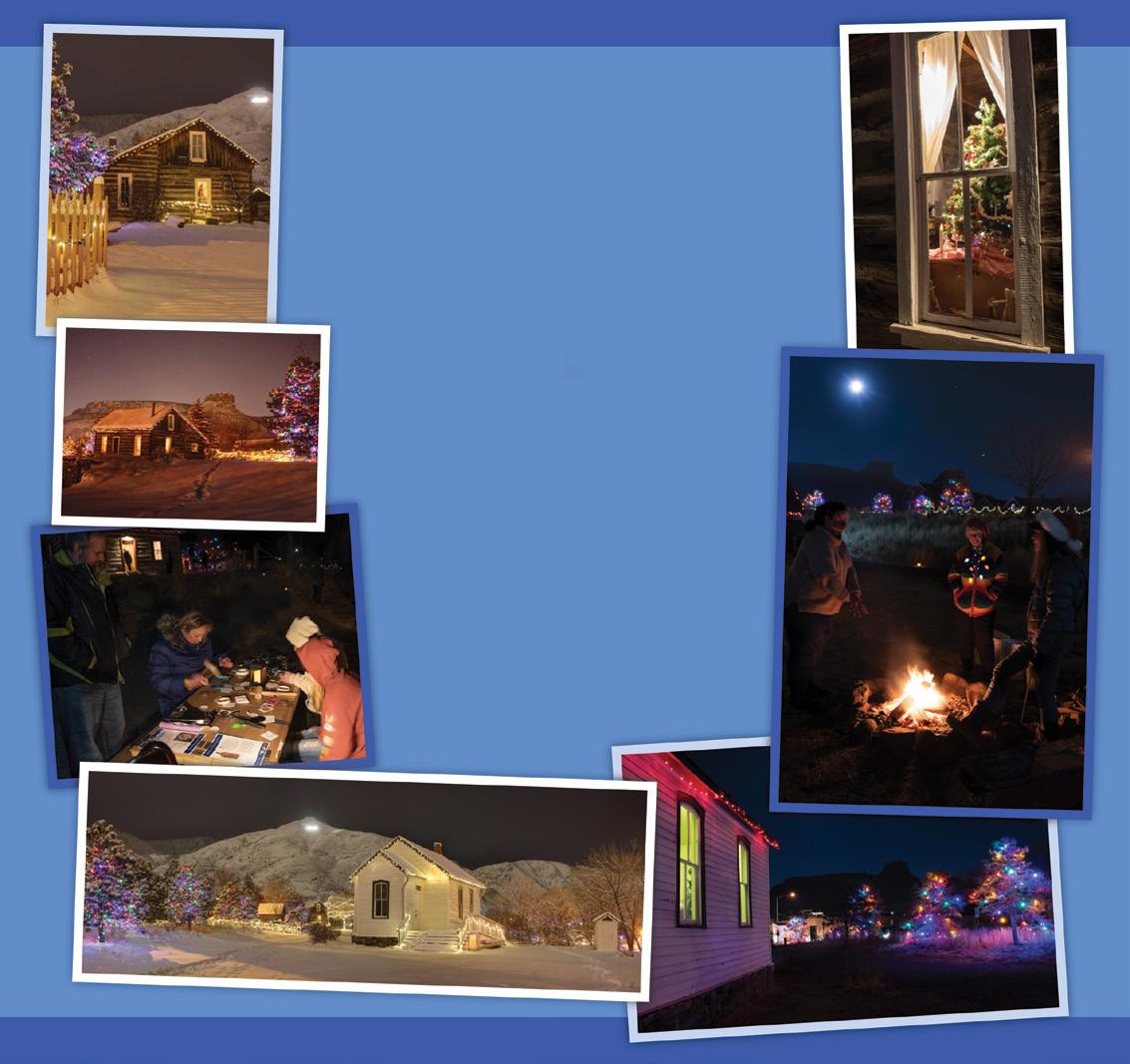
Advance registration via eventbrite is required. For more information, go to GoldenHistory.org/events
923 10th St., Golden, Colorado 80401
1
2 2 2 1 1
Holidays for the H
1
Photos © Povy Kendal Atchison (1), Andrew Terrill (2)









 By Mark Dodge, Curator
By Mark Dodge, Curator



































